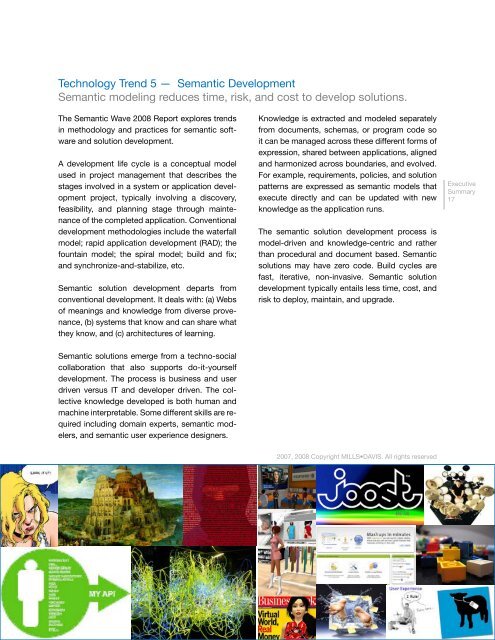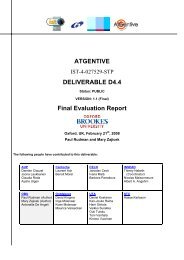Industry Roadmap to Web 3.0 & Multibillion Dollar ... - INSEAD CALT
Industry Roadmap to Web 3.0 & Multibillion Dollar ... - INSEAD CALT
Industry Roadmap to Web 3.0 & Multibillion Dollar ... - INSEAD CALT
Create successful ePaper yourself
Turn your PDF publications into a flip-book with our unique Google optimized e-Paper software.
Technology Trend 5 — Semantic Development<br />
Semantic modeling reduces time, risk, and cost <strong>to</strong> develop solutions.<br />
The Semantic Wave 2008 Report explores trends<br />
in methodology and practices for semantic software<br />
and solution development.<br />
A development life cycle is a conceptual model<br />
used in project management that describes the<br />
stages involved in a system or application development<br />
project, typically involving a discovery,<br />
feasibility, and planning stage through maintenance<br />
of the completed application. Conventional<br />
development methodologies include the waterfall<br />
model; rapid application development (RAD); the<br />
fountain model; the spiral model; build and fix;<br />
and synchronize-and-stabilize, etc.<br />
Semantic solution development departs from<br />
conventional development. It deals with: (a) <strong>Web</strong>s<br />
of meanings and knowledge from diverse provenance,<br />
(b) systems that know and can share what<br />
they know, and (c) architectures of learning.<br />
Knowledge is extracted and modeled separately<br />
from documents, schemas, or program code so<br />
it can be managed across these different forms of<br />
expression, shared between applications, aligned<br />
and harmonized across boundaries, and evolved.<br />
For example, requirements, policies, and solution<br />
patterns are expressed as semantic models that<br />
execute directly and can be updated with new<br />
knowledge as the application runs.<br />
The semantic solution development process is<br />
model-driven and knowledge-centric and rather<br />
than procedural and document based. Semantic<br />
solutions may have zero code. Build cycles are<br />
fast, iterative, non-invasive. Semantic solution<br />
development typically entails less time, cost, and<br />
risk <strong>to</strong> deploy, maintain, and upgrade.<br />
Executive<br />
Summary<br />
17<br />
Semantic solutions emerge from a techno-social<br />
collaboration that also supports do-it-yourself<br />
development. The process is business and user<br />
driven versus IT and developer driven. The collective<br />
knowledge developed is both human and<br />
machine interpretable. Some different skills are required<br />
including domain experts, semantic modelers,<br />
and semantic user experience designers.<br />
2007, 2008 Copyright MILLS•DAVIS. All rights reserved<br />
2007, 2008 Copyright MILLS•DAVIS. All rights reserved
















